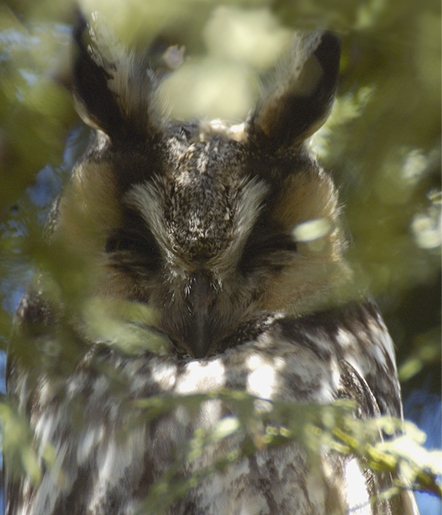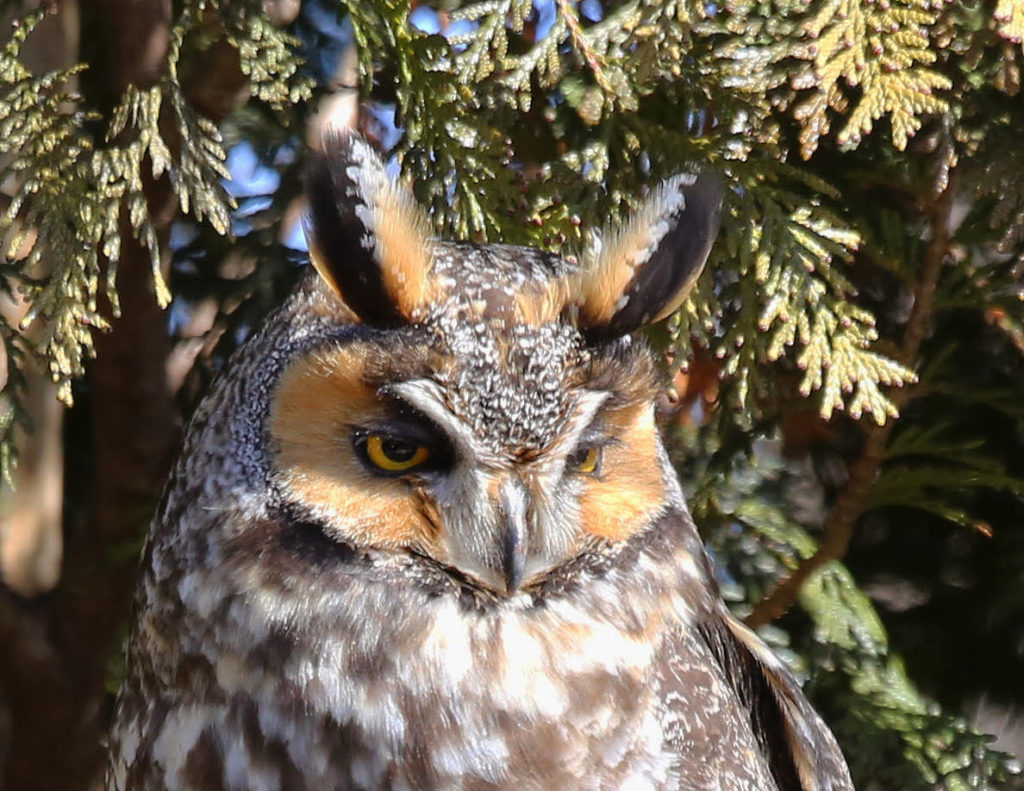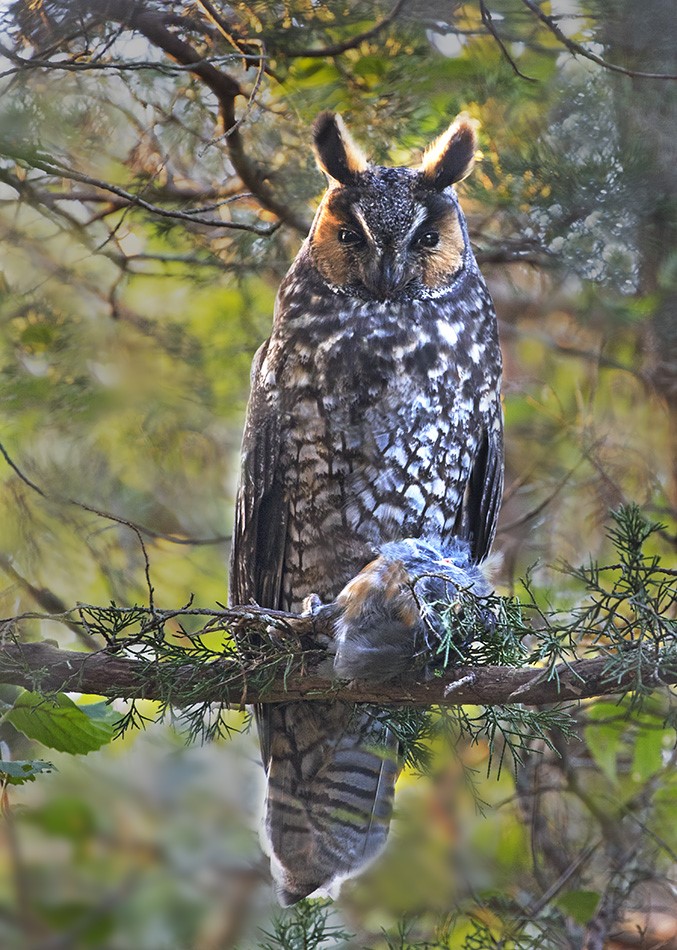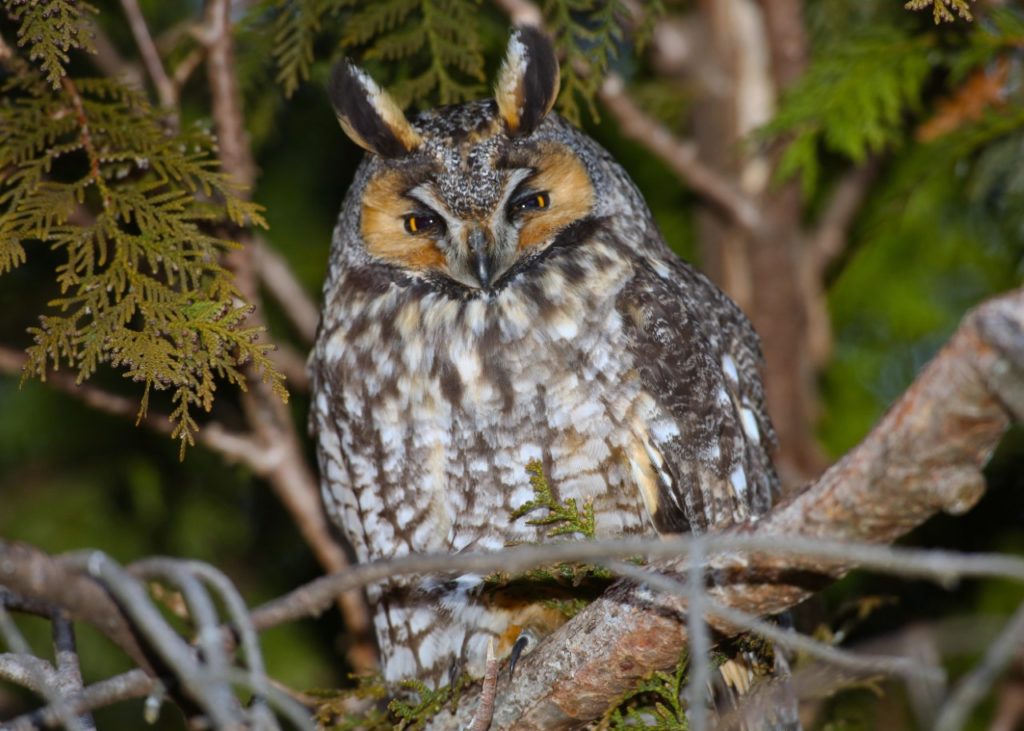An Owl Appears
I can still hear the excitement in my friend Debbie Graffius’ voice as she explained what she was seeing. She was looking in her yard at a large owl with ear tufts. She knew enough to know it was not a Great-horned Owl.
At this point, I grabbed my binoculars, as there was only one answer. I quickly headed to her house in the north part of Grosse Pointe Woods (not far from Lake Shore). Sure enough, perched on a limb open to the sun, yet protected by surrounding evergreens, was a Long-eared Owl. When Debbie’s husband John returned home, his photography skills came into play. Some excellent shots of this comfortably roosting owl resulted.
A Little Bit of Background…
We spotted this bird on March 29th of 2013. We don’t often see Long-eared Owls in our area. The only other time I am aware of was in April 2004, when Tufted Titmice in my yard began to scold. This led to an investigation on my part. Sure enough, a Long-eared Owl was in the evergreens in my 75 x 150 Grosse Pointe Woods yard. This is a great testimony to the need for evergreens as shelter. The bird did not budge during the daylight. Mike Florian, my good buddy and President of the Grosse Pointe Camera Club, was able to get some great photo opportunities that day.
This behavior is typical of Long-eared Owls do. They roost during the day in dense evergreens, typically near field edges. When trying to conceal themselves, Long-eared Owls sit erect, tightening their body feathers,“ear” tufts sticking straight up. One of the most interesting facts I have read about these owls is how they use the same distraction technique as that of Killdeer. When luring predators away from the nest, both the owl and the killdeer often feign a broken wing as they drag themselves along the ground.

Long-eared Owl (Photo by Mike Florian)
Bird Stats
The wingspan-to-body-length ratio of this bird is quite amazing; head to toe it is only 13 – 16 inches tall, with a wingspan tripling that at 39 inches! For a bird this size, it is amazing they weigh only 8 ounces to 1 pound.
To raise their young, Long-eared Owls use the abandoned nests of hawks and crows. These are usually 20 feet or more above ground. They lay between 2 – 10 eggs, with an incubation period of 35 – 40 days. The young are fed the same diet as the adults, torn into bite-sized pieces. This diet consists of mammals including: mice, shrews, voles, rats, rabbits and less commonly, birds. The adults kill the prey with a bite to the back of the neck of the mammal, and eat their prey whole.

Long-eared Owl (Photo by John Graffius)
Owl sounds are always magical to me, and the sounds of a Long-eared Owl are no exception. The male gives a low hoot call, similar to the sound of blowing across the top of an empty bottle. The owls repeat this call sometimes up to 200 times, between 2 -4 seconds apart. The sound carries more than a half mile away. When disturbed during nesting season, the owls clack their mandibles together and also give a call that sounds like the bark of a small dog.
As set forth on the Cornell web-site, Long-eared Owls are rated as a 13 out of 20 on the Continental Concern Score and they are listed on the 2016 State of North America’s Birds Watch List. This list was compiled to bring attention to those species that are at risk of extinction unless conservation measures are taken to reverse the challenges that they face. For Long-eared Owls, this includes loss of habitat including wooded areas and grasslands. Continued protection of our small wetlands is a step in the right direction for this species’ survival, since many of these wetland areas are adjacent to wooded areas.
Final Reflections

Long-eared Owl (Photo by Kevin Karlson)
Some of my best memories of this bird is watching their moth-like flight as they lift from the trees at dusk at Whitefish Point, on their way to migrate further north. This is when their wingspan can truly be appreciated. Knowing this is their behavior, I advised Deb and John if we sat and patiently watched the Long-eared Owl in their yard, it would become active at dusk. And as if on cue, when the sun began to set, the bird sat more erect and stretched its wings. Looking about, it then flew to the top of the nearest phone pole and after another stretch, lifted itself and headed north.
Do you want to see this owl? Mark your calendar for the Michigan Audubon Spring Fling on April 28th and 29th at Whitefish Point in Paradise, Michigan. Stand on the hawk watch platform at dusk and wait for the magic to begin.
Enjoy your birds!
Rosann Kovalcik, Owner
Wild Birds Unlimited, Grosse Pointe Woods
Have you joined our email list? Click here to sign up, it’s free and gives you access to sales, coupons, nature news, events, and more!

